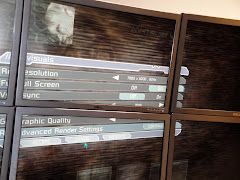As I mentioned in a previous posting, Eyefinity was originally conceived for gamers. Sure business and other users will love it, perhaps more than gamers will, but my inspiration came from games. The first SunSp*t (the original name) slide deck illustrated how it is possible to build large high resolution displays from inexpensive panels. The specific example I used was six $149 22inch 1440H by 900V panels. In other words 4320H 1800V and 61" diagonally for $900. Wow!
At that time I didn't think a configuration other than 3W2H Landscape (hereinafter referred to as 3x2L) might be more desirable. That thought came much later.
At a later point in time, that stimulating architect (see Why Eyefinity Supports Six Displays) was pressuring me up over mullion management (the technical term for managing bezel interference), particularly since in 3x2L the horizontal line could be very distracting. My response had been, "well the ISVs will design around it once they see SunSp*t" (because after all it was so cool they had to, right?). At the same time we were discussing how many business folks would use a 3x1P (3W 1H Portrait) "constellation" of displays, because many documents are historically taller than they are wide. During that discussion it suddenly hit me that 3x1P would be the most preferred gaming constellation because:
- Three displays are cheaper than six
- HD aspect ratios are more closely preserved than with 3x2L
- and most importantly there is no bezel through the middle of a display
Yes we had discussed this earlier, but it didn't stick. I am pretty sure I know why. But late in the development of SunSp*t 3x1P caught on with a vengeance. It may seem weird that I failed to apply my own maxim about odd dimensions in the vertical direction. I applied it in the horizontal. There was a reason for that though.
More...

No comments:
Post a Comment